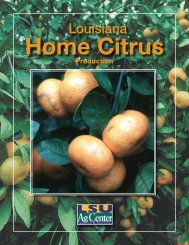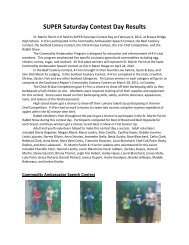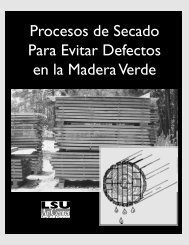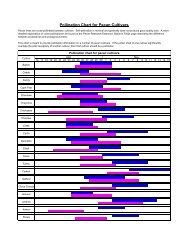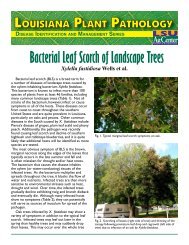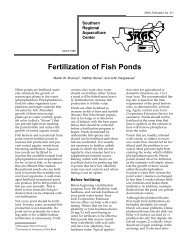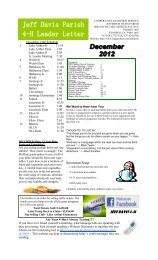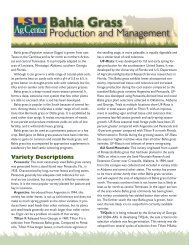Cocahoe Minnow - The LSU AgCenter
Cocahoe Minnow - The LSU AgCenter
Cocahoe Minnow - The LSU AgCenter
You also want an ePaper? Increase the reach of your titles
YUMPU automatically turns print PDFs into web optimized ePapers that Google loves.
kits based on glass ampules with contents that change<br />
color depending on the oxygen content of the water -<br />
for a cost of roughly $1 per test.<br />
Oxygen concentrations in tanks should be maintained<br />
above five parts per million (ppm) at all times.<br />
However, these levels may be difficult or impossible to<br />
attain when only using agitators – an oxygen cylinder<br />
with tubing and air stones is a more practical, efficient<br />
approach for maintaining adequate dissolved oxygen in<br />
tanks. Additionally, excessive agitation can be harmful<br />
to delicate scaled fish. For all of these reasons, diffused<br />
oxygen is the preferred aeration method for holding<br />
and hauling small fish.<br />
Figure 9.2 Oxygen cylinders and hauling tank on trailer ready<br />
for transport. Photo: Greg Lutz<br />
Oxygen cylinders are available from some industrial gas<br />
or welding suppliers. Pressure regulators are needed for<br />
each oxygen tank, and flow meters can be installed to<br />
adjust oxygen flow rates. Various diffusers such as air<br />
stones or porous tubing are available commercially for<br />
dispersing oxygen in the hauling tank.<br />
Agitators can be used either alone or in combination<br />
with pure oxygen. Agitators also provide back-up<br />
aeration for emergencies when oxygen supplies run<br />
out. Cooling water with ice reduces metabolism rates<br />
of fish and increases the solubility of oxygen in the<br />
water. As fish breathe, over time carbon dioxide (CO 2 )<br />
will accumulate in the tank. High oxygen levels, air<br />
circulation and water agitation during hauling will all<br />
help to reduce any adverse effects from accumulated<br />
17<br />
CO 2 . Adding baking soda could also help to neutralize<br />
the carbonic acid that comes from CO 2 in water.<br />
Other Water Quality Characteristics<br />
Salinity, water hardness, alkalinity and pH test kits<br />
should be used to check transport and waters the fish will<br />
be held in. If you deliver fish to sites where chlorinated<br />
water is used, a chlorine test kit is also helpful to be<br />
sure chlorine in waters has<br />
been neutralized. If not,<br />
chlorine and chloramine<br />
neutralizers will be needed<br />
to dechlorinate water.<br />
Ammonia can also increase<br />
in hauling situations and is<br />
not removed by agitation.<br />
Fasting fish before<br />
Figure 9.3 A refractometer<br />
is a relatively inexpensive<br />
instrument for checking<br />
salinity. Digital salinity meters<br />
are more costly but can be<br />
more precise. Different models<br />
can also measure other water<br />
quality characteristics. Photo:<br />
Jill Christoferson<br />
transport, using clean water,<br />
and lowering the water<br />
temperature all help reduce<br />
ammonia. Ideally, the pH<br />
of hauling water should be 7<br />
to 7.5; higher pH increases<br />
the toxicity of ammonia to<br />
aquatic animals.<br />
Chronic fish losses or weak fish problems are often<br />
associated with handling and transporting fish in soft<br />
water or transferring fish from saltwater to freshwater.<br />
Hardness and alkalinity levels from 50 to 100 ppm are<br />
preferable. Sodium bicarbonate and calcium chloride<br />
will increase alkalinity and hardness and are safe to use.<br />
Add approximately 1 teaspoon of baking soda per 100<br />
gallons of water to increase the alkalinity by 10 ppm.<br />
Add about 6 teaspoons full of calcium chloride per 100<br />
gallons to increase the hardness by 50 ppm.<br />
Hauling Tank Design and Construction<br />
Most commercially manufactured hauling tanks are<br />
insulated. Urethane foam, plastic foam and corkboard<br />
are common insulating materials, but they can also be<br />
used with homemade tanks, glued to the outer surface.<br />
Tanks should be equipped with an overflow drain to<br />
maintain water level and allow agitators to function<br />
at the proper operating depth. Another feature is an<br />
air vent or scoop to permit air circulation in the space<br />
between the water surface and top of the tank.




